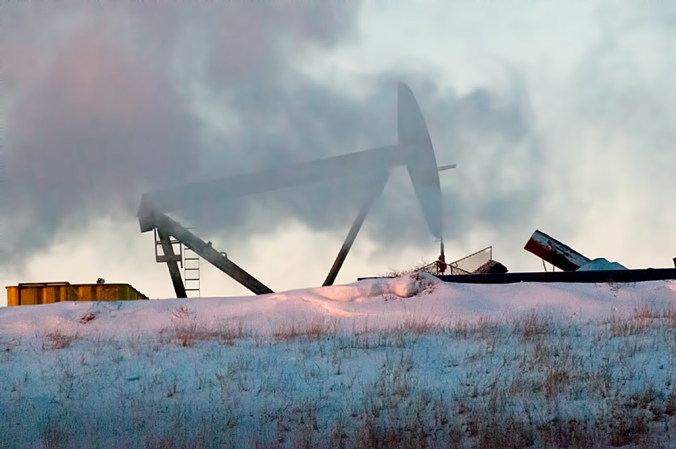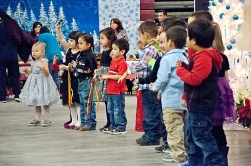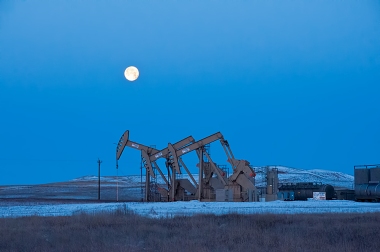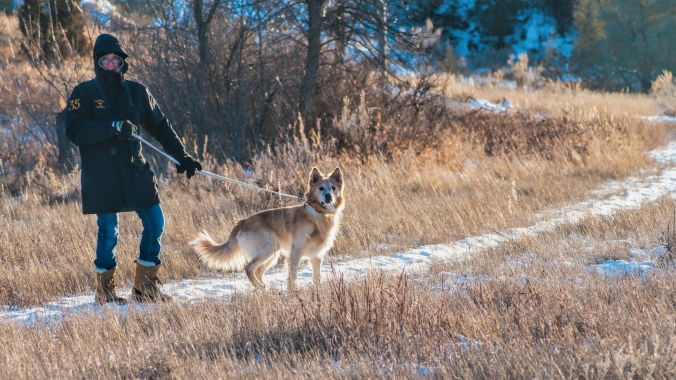(note: I wrote this article for the news site called Bakken.com where it appeared Christmas week. Check Bakken.com for more news and information from the Bakken region.)

Early morning steam rises from an oil rig site near New Town
The Bakken Boom is not what it used to be – it appears the region is moving past the pressure of Bakken birth pangs, the extreme pain caused by the birth of the region’s latest oil boom.

Blue Buttes near Mandaree, ND
After a three-day business tour of the Bakken region for Bakken.com, it’s apparent that Western North Dakota is not the peaceful wilderness ranch country of legend. It has a buzz, it is busy, but it is business and business is great. We found several categories in which reality falls short of the fearsome fantasies foisted on folks farther east.

Andrew Lutz, Business Development Manager for Bakken.com
Andrew Lutz, the Bakken.com Business Development Manager and I met up in the heart of the oil country – downtown Watford City. It’s a region I’m familiar with having lived and worked here a few years ago. Now I make regular, even monthly visits to Western North Dakota.

Dakota West Credit Union’s 3-story building on the north end of Watford City’s Main Street
The center of the region’s most productive oil county is McKenzie County. Combined with Mountrail County it represents one of the largest oil-producing regions in the world.

Workers are adding a large addition to the front of the McKenzie County Courthouse.
Changes continue to alter Watford City. Even the Courthouse is a construction zone.
The county’s skillful and wise business leadership is steering the city in to the next era. Bakken.com will tell you about those changes in a story with Economic Development Director Gene Veeder.
On this trip, I rode with Andrew, and that gave me a rare opportunity to see the sights instead of the pilot. Though we had spoken by phone and by email, our first face-to-face meeting was at one of the most outstanding steakhouses outside of a major city, Outlaws Bar and Grille.

Outlaws Bar and Grill, Watford City is a family oriented eatery.
It’s clean, comfortable and the cost is reasonable, just what you would expect to pay in Fargo or Bismarck. Our first meal there was good enough the first night to bring us back the second night. The wait staff was busy with a full dining room. By the time Andrew and I left, a line of customers waited for our table, ready to add even more urgency to the scurrying troop of table-servers. Our young waitress the second night, appeared inexperienced and uncertain; she stumbled her way through the serving, but no fouls and no strikes.
Breakfast both days was at the long-time local landmark the Little Missouri Grille on Highway 85 on the western edge of Watford City. Its customers for years has been area ranchers, families, travelers and tourists. These days, according to the manager, the restaurant floods with hungry men beginning the moment the doors open at 6 a.m.
One of the reasons it’s popular is its serving portions. I like a restaurant that uses the entire plate instead of little separated and compartmentalized servings. The Little Missouri’s portions are man-sized, and that’s what other customers we talked to said they liked about the restaurant. Plates are full and stacked. Work crews who eat at the Little Missouri get their days started on a full stomach – and messages from home via smart phones.
A second reason for popularity is its wait staff. Our servers on both days were busy, fast and efficient, but very personable and took time for a little small talk while taking our order, filling our coffee cups and clearing our plates.
Our waitress the second morning told us she moved to Watford City from Idaho to be a waitress because she heard the pay was good.
“Is it that good?” I asked her.
“Oh yes,” she smiled as she refilled my coffee. “Much better.”

Brittany, the waitress from Idaho at the Little Missouri Grille in Watford City.
On this trip, we did not find the rudeness, lazy workers, sub-standard service or high prices we were warned about. From the Cash Wise Grocery Store to the Kum-and-Go gas station, we found service was professional and efficient.
Business owners we talked to in Watford City and New Town said their employees are keeping up with the flood of new business, but not easily. At United Prairie in New Town, General Manager John Reese said the staff has grown in the last 10 years and that makes it tough to find adequate housing. That’s why his company is building housing for company families.
Perhaps the biggest challenge of stopping for a meal in town is getting back on the highway. Outside of town traffic flows orderly, but in town, be prepared for an infrequent moment to enter traffic. Left turns are especially difficult.

Looking south from Watford City. Highway 85 used to be lonely drive, but not any more.
The North Dakota Department of Transportation is widening highways, adding passing lanes and turning lanes to help alleviate traffic tie ups and make the highways safer. Additional work is ready to begin in 2014.
With grace and common sense, it is no challenge to navigate traffic in towns such as Watford City, New Town or Williston. Like red cells in a blood stream, an endless stream of 18-wheelers, pickup trucks and cars flow through the heart of the Bakken. Stop lights and stop signs are the valves that slow down traffic for safety, but they add to the time required to get through the main arteries of the cities. So, if you’re planning to drive highway 85, 200 or 2 through the Bakken, be ready for backups in town.
The North Dakota DOT is coming to the rescue of many of these smaller towns with by-pass surgery, building routes around the cities – a sign that the Bakken birth pains are abating.

Highway 85 construction halted for the winter, but will resume in 2014.
When Andrew and I left Watford City to head to New Town, we followed a convoy of oil service trucks. The good news is the road surface is good, again a testimony to the attention the North Dakota DOT has given its highways. Traffic moves safely, drivers are attentive and courteous. Passing is limited on the hilly Highway 23. Be prepared to drive trucker-speed which may mean a bit under the speed limit on up-grades. Also, just as in town, left turns can cause a traffic tie up. We saw no road rage evidenced by one-finger salutes or horn blasts. Drivers kept a safe distance from the vehicle ahead of them. Functioning brakes lights are life savers – make sure you have them and watch for them in front of you when driving in the Bakken.
Driving across McKenzie County to New Town, there is no place where you do not see at least one, if not many drilling rigs and pump jacks. Next to the road, or off on the horizon, you can see why the Bakken is a major world player in oil production and extraction.

South and west of the Three Affiliated Tribes business office, one of the oil sites on the reservation is clearly visible, flaring natural gas in a large flame.
Our first stop on the way in to New Town was the business office of the Mandan, Hidatsa and Arikara Nation, the Three Affiliated Tribes. Our mission was to visit with Chairman Tex Hall.

Father Roger Syneck and Tribal ChairmanTex Hall pause during the blessing of the meal at the Elder’s Christmas Party.
We arrived at the start of the annual Three Affiliated Tribes Elders Christmas Party. Our timing was perfect. Chairman Hall was on the riser with the local Roman Catholic Priest giving the blessing. Elders are treated to a full meal at the Four Bears Casino Events Center, presented with gift bags and Christmas checks and serenaded by the children of the Head Start program.

Head Start children sing at the Elder’s Christmas Party.
Members of the Three Affiliated Tribes benefit from oil activity and Chairman Hall’s pro-business philosophy. Oil production is expanding.

Railroad spur leading in to the transload facility on the east end of New Town.

Construction continues on the transload facility on the east end of New Town.
Transload facilities in New Town and Van Hook are adding permanent income to the local economy.
News and events from the Bakken are incomplete without solid representation from the Fort Berthold Indian Reservation and the Three Affiliated Tribes. That’s why Bakken.com is working with Chairman Hall and others on Fort Berthold to tell the stories of the region. Chairman Hall told us he is working on several issues to help his people gain even more benefit from oil production and avoid some of the challenges of the expanding industry. Those issues including flaring and an oil refinery are issues Bakken.com follow.
The hospitality of the region is legendary and after meeting with Chairman Hall, we were warmly greeted by the Chairman and CEO of Lakeside State Bank of New Town. Gary Peterson’s bank has grown along with the Bakken economy. He showed us figures that Lakeside State Bank’s business is several times greater now than just a few months ago. Larger numbers of customers and their transactions such as wire transfers means more work for his staff, but the swelling customer base is evidence the staff handles the extra work load.
After New Town, we drove to Stanley, Ray, Tioga and Williston.

Long before the current Bakken boom, the Enbridge Storage Site south of Stanley has helped move petroleum to market.
Yes, the towns are challenged by the instant impact on infrastructure. They’re now getting in to the pace, working with developers to meet one of the greatest needs – housing. It’s not just the structures that must be built, but also streets, sewers, water, lights and law enforcement. New condominiums, apartment complexes, single-family homes and RV parks seem to have popped out of the ground like toadstools on an over-watered golf green. The housing shortage is not over, but at this stage, developers and city fathers we spoke to are watching trends to help make sure the housing shortage does not become a housing glut. They’ve become skittish after watching the last oil bust 30 years ago.
During our drive through the Bakken region, we scanned the horizon checking out rigs, pump jacks, storage facilities and support services. Our roadside survey found gave visual proof to recent maps and stats that indicate most of the oil activity spreads from McKenzie County east.
As we drove west in to Sidney, Montana fewer drilling rigs and pump jacks were spotted. Sidney is home to many of the oil field services that Bakken.com works with. Compared to Watford City and Williston, life in Sidney is more peaceful and orderly. Though activity is further east, westward expansion is predicted.

Traffic in Sidney, MT is comparatively light compared to other cities in the Bakken region.
Some oil field services, landmen and engineers working in the Bakken may have local offices in other cities, but they are headquartered in Sidney. Most work from the home offices in Sidney can be done by phone or Internet– away from the intensity. It provides staff a quick access of about an hour to most of the oil activity east of Sidney while at the same time being a step removed from the congestion. Either Highway 200 or 68 carry most of the traffic. With Andrew at the helm, we drove 68 to Sidney and Highway 200 on the return trip. (Incidentally, Highway 200 across the Yellowstone gives travelers a look at the region’s only lift bridge – used only once.)

Lift Bridge along Highway 200 east of Sidney.
We found Highway 68 to be the quickest with the least traffic. Highway 200 requires drivers to negotiate hilly terrain with more truck traffic.
Finally, to those who cry the beauty of the Badlands is marred by oil exploration, I must argue. For 20 years I’ve backpacked, camped, cross country skied and rode horses in the region. It’s still beautiful.

Long X Bridge south of Watford City where big horn sheep roam.
Oil companies meet environmental regulations, and go even further to try to do their work without disturbing the natural habitat of elk, deer, mountain lions, and big horn sheep (which were eliminated from the region in the 1920’s but have been brought back along with the oil field activity).
As Andrew and I discovered, the beauty is still there to behold, even from the heated protection of a car. Early morning jaunts in to the area can produce amazing images that incorporate the wells, pumps and roads of oil activity.

The birth pangs of the Bakken Boom are giving way to a more settled way of life. It’s not as bad as you heard out here in western North Dakota. Embellished and enhanced stories repeated by those outside the region do a dis-service to the reality of the dynamic benefits of oil. Once again, as with power plants, coal mines and farmland, this part of America is serving the needs of the United States and the world. North Dakota’s cultural landscape has changed much over the years. That’s why there are so many abandoned homesteads and buildings across the landscape. The current oil activity may bring a change in culture, but what hasn’t changed in America in the last 200 years?

 Some will go cross-country skiing. Cross Ranch, a quiet state park where groomed cross-country ski trails weave through a cottonwood forest that stood here when Lewis and Clark tugged their boats up the Missouri River.
Some will go cross-country skiing. Cross Ranch, a quiet state park where groomed cross-country ski trails weave through a cottonwood forest that stood here when Lewis and Clark tugged their boats up the Missouri River.
 The wood stove sits quiet, unused and neglected much of the year. However, this time of the year, it’s actually a rewarding way to get out of the cold. I love burning wood to stay warm.
The wood stove sits quiet, unused and neglected much of the year. However, this time of the year, it’s actually a rewarding way to get out of the cold. I love burning wood to stay warm.



















 up to the challenge…it will be a good day for photos, or to just hike. Anyone with good hiking boots who dresses warm can hike the region, you don’t need snowshoes.
up to the challenge…it will be a good day for photos, or to just hike. Anyone with good hiking boots who dresses warm can hike the region, you don’t need snowshoes.













































